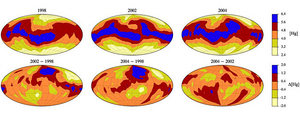The drifting clouds scientists have seen are wispy, "just like cirrus clouds on Earth"-except these are made of mercury, explained astrophysicist Oleg Kochukhov at Uppsala University in Sweden.
Investigating these metal clouds might shed light on how elements form inside stars.
Kochukhov and his colleagues spent seven years peering at alpha Andromedae, the brightest star in the Andromeda constellation. The bluish-white star lies about 100 light-years from Earth and is more than twice as hot as the Sun and roughly three times its mass and diameter.
Stars can develop spots on their surfaces, which are largely thought due to magnetic fields. These are how sunspots on the Sun are created, for instance. However, alpha Andromedae is not magnetic, so the spots Kochukhov and his colleagues discovered on it five years ago were an enigma.
Now the researchers find these spots are clouds in that form and disperse in alpha Andromedae's skies, following dynamics similar to weather patterns on planets, findings detailed online June 24 in the journal Nature Physics.
Such weather could be seen on stars that, like alpha Andromedae, are hot and massive. They also have to spin relatively slowly-alpha Andromedae completely rotates about once every 60 hours-as spinning too fast might destroy any clouds. Kochukhov noted a half-dozen or so other candidates have recently been seen already, including the star AR Aurigae, which might have clouds of strontium, yttrium and platinum as well.
Mystery process
What makes these metal clouds form remains uncertain. Kochukhov suggested random disturbances in alpha Andromedae's atmosphere could generate clouds, "a process similar to what is quite often seen in the atmosphere of our own planet," or perhaps the gravitational pull of alpha Andromedae's companion star helps perturb its sky.
The discovery of weather on stars could help solve a mystery concerning why startling discrepancies were seen in the levels of mercury and other heavy elements in stars like alpha Andromedae.

|
| ©Oleg Kochukhov/Uppsala University |
| Maps mercuric weather above alpha Andromedae each year (top row) and the accumulative change in mercury surrounding the star (bottom row) |
"These are all the same type of star, so you'd expect them all to have roughly the same abundances of mercury, but they could vary by a factor of 100 from one star to the next," explained George Preston, astronomer emeritus at the Carnegie Observatories, who did not participate in this study. "Now it turns out this variation could be due to weather. You might see different amounts of mercury at different times."
Alpha Andromedae and similar stars "are critical to understanding the origin of elements," Kochukhov said, as heavy elements are concentrated in them that are too faint to detect in sun-like stars. Stellar weather could shed light on how elements mix around in these stars, he added.



Reader Comments
to our Newsletter